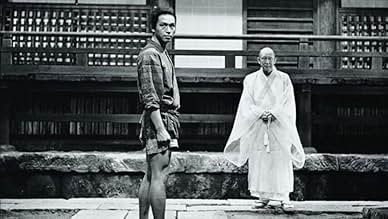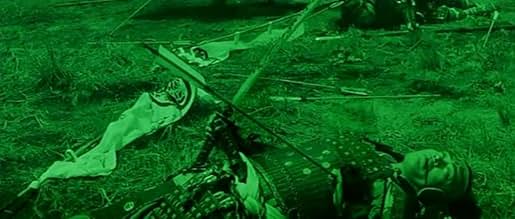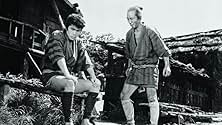Füge eine Handlung in deiner Sprache hinzuA young man decides to become a warrior, causing trouble for his clan.A young man decides to become a warrior, causing trouble for his clan.A young man decides to become a warrior, causing trouble for his clan.
- Regie
- Drehbuch
- Hauptbesetzung
- Auszeichnungen
- 1 wins total
Kôshirô Matsumoto
- Sozo, 1st son
- (as Somegoro Ichikawa)
Kichiemon Nakamura
- Yasuzo, 2nd son
- (as Mannosuke Nakamura)
Empfohlene Bewertungen
There's a rare sense of epic artistry in this unusual and striking medieval saga, directed by Keisuke Kinoshita as more of an aesthetic experience than a conventional drama. The film was designed to resemble a decorative 16th century Japanese scroll, painting spare brushstrokes of vivid color across each panoramic, wide-screen black and white image. It can be difficult (and not really worth the effort) to follow the endless progression of characters, and the manner in which the film unfolds is often more involving than the story it presents. Each leap forward in time approximates the turning of another page, usually to the next in a series of pointless, bloody battles between feudal warlords, with each conflict properly labeled beforehand, identifying the date, location, and principals involved. The battle scenes serve as punctuation, following successive generations of peasant soldiers to their doom, with the repetition suggesting that war is the only eternal aspect of the human condition, and passive resistance is futile.
I would really love to see again this film, which I've seen in São Paulo in 1961. Besides the positive aspects mentioned by the reviews already posted, I would emphasize another quality: some events are presented two or three times from the point of view of the different characters. As the events are not organized in chronological order, and the situations, faces and happenings are similar, the film seems absolutely confusing, till you realize what is intended to be shown: the reality is repetitive, but unique for each person, and each event must be understood from different angles. It's a pity that this film is not available on DVD.
Rating - 4/10
The enigmatic title is explained near the end, which more or less paraphrases "Ol' Man River" - he just keeps rollin' along, regardless of the follies of man. The films set in the "turbulent century", and was it ever ! The film's two hours covers about 70 years, and there's a battle nearly every five minutes. The large cast of characters, principally of one small family, deal with the age-old problem of the young getting carried away with war and the older warning them how futile it all is. There are a number of deaths which coincide closely with births, and the characters assume they therefore know where the souls have reincarnated.
The war-is-futile message is hammered home without subtlety and, despite the downtrodden gaining occasional triumphs, it's all very depressing. The only character who has a good laugh is killed shortly afterwards, and partly for that reason !
The strange aspect of this film is that it is part-colourized. In many frames, these are simply large splashes of colour laid-over, and they look terrible and amateurish. Other frames have more minute and detailed colorization, which is quite pleasant. But the film would have looked better if it had stuck to B&W only.
The four points I've awarded this film are mainly for the acting, which is good to great throughout. The oval-faced beauty Hideko Takamine is very watchable for the first half at least, but has far less to do than some of her other roles. The actress (name unknown) who plays the pretend-madwoman Tatsu is a standout.
But it takes more than good acting to make a good pic. I cannot recommend this pic.
The enigmatic title is explained near the end, which more or less paraphrases "Ol' Man River" - he just keeps rollin' along, regardless of the follies of man. The films set in the "turbulent century", and was it ever ! The film's two hours covers about 70 years, and there's a battle nearly every five minutes. The large cast of characters, principally of one small family, deal with the age-old problem of the young getting carried away with war and the older warning them how futile it all is. There are a number of deaths which coincide closely with births, and the characters assume they therefore know where the souls have reincarnated.
The war-is-futile message is hammered home without subtlety and, despite the downtrodden gaining occasional triumphs, it's all very depressing. The only character who has a good laugh is killed shortly afterwards, and partly for that reason !
The strange aspect of this film is that it is part-colourized. In many frames, these are simply large splashes of colour laid-over, and they look terrible and amateurish. Other frames have more minute and detailed colorization, which is quite pleasant. But the film would have looked better if it had stuck to B&W only.
The four points I've awarded this film are mainly for the acting, which is good to great throughout. The oval-faced beauty Hideko Takamine is very watchable for the first half at least, but has far less to do than some of her other roles. The actress (name unknown) who plays the pretend-madwoman Tatsu is a standout.
But it takes more than good acting to make a good pic. I cannot recommend this pic.
This is the saga of a family of farmers, some of whom become distinguished soldiers and even generals. It begins the evening when one of their numbers comes home, having captured an enemy general, earning great praise. That night, his nephew is born, as is the son of the local daimyo. We don't follow the nobleman, but the farmer, as he grows up, is persuaded not to run off to war by getting him a wife, has sons and daughter, and.... well, 'persists' is the best word I can think of, while other men in his family go to war and die, while the women move to town, and go mad, while the river Fuefuki flows outside the house that everyone refers to as an 'insect trap.'
Keisuke Kinoshita's movie is an epic, but it breaks the rules, by being an anti-war epic. It's shot in wide screen, with an aspect ratio of 2.35:1, but it's not shot in color, color is shot through it, in tints and tones and what looks like Handschlegel effects, and gels that color part of the screen like airbrushed clouds. This is the war of the samurai class, so these splashes of color suggest old scrolls. However, that's during battles, and the aftermath. When it's just the peasants, and no one is dying, it's all black and white. Back when this was made, black & white was the film of reality. Color was for fantasy, or perhaps madness. Over all, it's saying "We could do this sort of movie straight and make the Big Bucks. That's not we want to do."
There's quite a cast, and Kinoshita and his regular cameraman, Hiroshi Kusuda, know how to fill that wide, wide screen. The samurai sequences are shot as well as anything that Kurosawa did, but his sequences lack Kurosawa's bravado.... and his humor. Kurosawa's samurai might be stupid, but they are always noble. There are no crippled mothers in Kurosawa, so far as I can recall, hobbling along as fast as a mounted army, begging her sons to come home. There are no samurai killing themselves so they won't suffer the agonies of burning to death, while priests sit calmly. There are no silk merchants burned to death because they dare to be rich in Kurosawa's films.... although perhaps he and his collaborators might write it so they deserve to die for other things. Because they are not samurai, they are merchants, and so they are evil.
Well, Kurosawa's family was a samurai family. I have no idea about Kinoshita's family. In 2019, this looks like going well overboard to make a point. Given the popularity of samurai movies when it was made, I'm not sure.
Keisuke Kinoshita's movie is an epic, but it breaks the rules, by being an anti-war epic. It's shot in wide screen, with an aspect ratio of 2.35:1, but it's not shot in color, color is shot through it, in tints and tones and what looks like Handschlegel effects, and gels that color part of the screen like airbrushed clouds. This is the war of the samurai class, so these splashes of color suggest old scrolls. However, that's during battles, and the aftermath. When it's just the peasants, and no one is dying, it's all black and white. Back when this was made, black & white was the film of reality. Color was for fantasy, or perhaps madness. Over all, it's saying "We could do this sort of movie straight and make the Big Bucks. That's not we want to do."
There's quite a cast, and Kinoshita and his regular cameraman, Hiroshi Kusuda, know how to fill that wide, wide screen. The samurai sequences are shot as well as anything that Kurosawa did, but his sequences lack Kurosawa's bravado.... and his humor. Kurosawa's samurai might be stupid, but they are always noble. There are no crippled mothers in Kurosawa, so far as I can recall, hobbling along as fast as a mounted army, begging her sons to come home. There are no samurai killing themselves so they won't suffer the agonies of burning to death, while priests sit calmly. There are no silk merchants burned to death because they dare to be rich in Kurosawa's films.... although perhaps he and his collaborators might write it so they deserve to die for other things. Because they are not samurai, they are merchants, and so they are evil.
Well, Kurosawa's family was a samurai family. I have no idea about Kinoshita's family. In 2019, this looks like going well overboard to make a point. Given the popularity of samurai movies when it was made, I'm not sure.
I have seen many Japanese films over the years and this film is one of the most breathtaking. During the film's 2 hours you are taken through generations of one family, with the film echoing the message that war leads to inevitable tragedy. The film is equally about Buddhism in the 1500s with re-incarnation, ghosts, rituals and temples being prominent to the story. In the background of the story is a grand wooden bridge that is a reminder of the dangerous world that lies across the water.
I'm a fan of the coloured on black and white visuals. It's odd but adds a strange feel to the film that matches the ancient Japan world. The battle scenes are brief but stunning. I don't think any were reused as 'WILLIAM FLANIGAN, PhD' stated in his review. That's got to be one of the worst reviews I have read. He gives points based on subtitles and restoration (which is dependent on the screening, so is useless to the reader), and not on acting, story and plot. He seems to care very little about the style and the substance of a film rather the technical aspects. Anyone who makes dodgy reviews while always signing his name in capitals with 'PhD' next to it, is a bit sad.
I'm a fan of the coloured on black and white visuals. It's odd but adds a strange feel to the film that matches the ancient Japan world. The battle scenes are brief but stunning. I don't think any were reused as 'WILLIAM FLANIGAN, PhD' stated in his review. That's got to be one of the worst reviews I have read. He gives points based on subtitles and restoration (which is dependent on the screening, so is useless to the reader), and not on acting, story and plot. He seems to care very little about the style and the substance of a film rather the technical aspects. Anyone who makes dodgy reviews while always signing his name in capitals with 'PhD' next to it, is a bit sad.
Wusstest du schon
- WissenswertesFinal film of Kuniko Igawa.
Top-Auswahl
Melde dich zum Bewerten an und greife auf die Watchlist für personalisierte Empfehlungen zu.
Details
- Laufzeit
- 1 Std. 57 Min.(117 min)
- Farbe
- Sound-Mix
- Seitenverhältnis
- 2.35 : 1
Zu dieser Seite beitragen
Bearbeitung vorschlagen oder fehlenden Inhalt hinzufügen


















